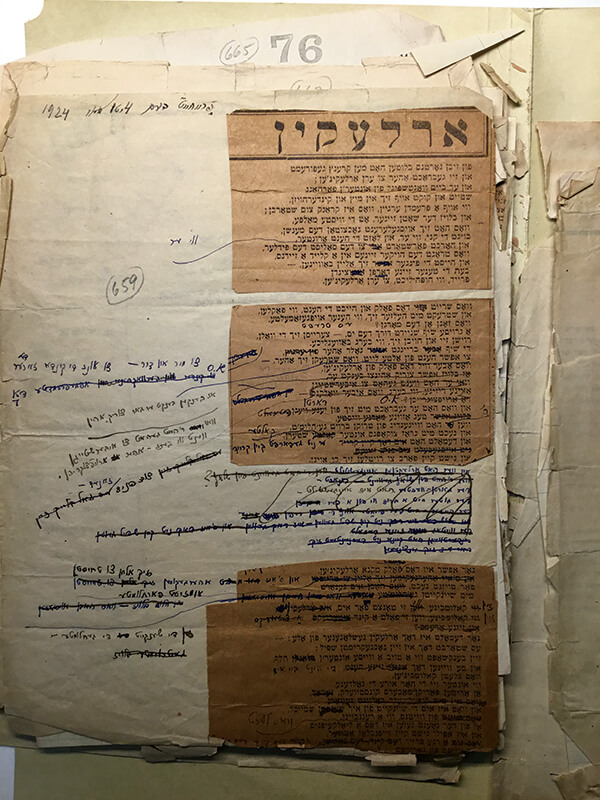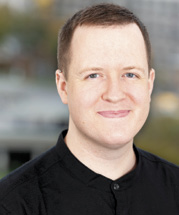Above: Detail from Drawing, late 19th century. Brush and gouache on cream paper, mounted on cream paper. 9 1/16 x 8 1/8 in. Cooper Hewitt, Smithsonian Design Museum, Gift of Friends of Drawings and Prints with special assistance from Theodore E. Stebbins, Jr. and Phyllis Dearborn Massar
Last summer, I made a short research trip to the archives of the YIVO Institute in New York. I was hoping to find materials that could shed light on the early life and work of the Yiddish poet Moyshe-Leyb Halpern (1886–1932), one of the protagonists of my dissertation. Halpern was born in a small city in eastern Galicia and, in 1908, immigrated to the United States, where he became a leading and contentious figure in the development of Yiddish modernism. Before his immigration, however, he lived for nine years in Vienna, where he apprenticed as a sign painter, studied at the university, and became involved in the famed literary culture of fin-de-siècle Austria. This near decade was a formidable time in Halpern’s life, but we still know relatively little about it.
Unfortunately, as is often the case with archival research, I came up short in New York. While I was sifting through Halpern’s papers, I became disheartened by the incompletion of the archive and by the erasures and losses that could be discerned, but not always filled in. My research on Halpern’s life and work in Vienna is thus “unfinished,” and it will remain on hold for at least the next several months, like so many other projects, because of COVID-19–related closures. In the archive, however, frustration and failure can often give way to surprise and excitement. Indeed, last summer, I did not find what I was looking for, but I was fascinated by what I did find in those grey boxes and manila folders.
The Halpern collection (RG 464) at YIVO contains, among other documents, a large number of newspaper clippings. Like many writers and public figures, Halpern would often cut out and save poems and essays that he had published in newspapers and magazines, as well as stories and reviews that concerned his work. Archives are full of such clippings, on yellowed and crumbling paper, and they rarely attract much notice. To my surprise, however, I learned that Halpern’s clippings were not merely attempts at preservation, but were rather central to his process of (re-)writing. I noticed that he would cut out his poems and glue them onto a separate piece of paper, and then correct, revise, and rewrite them by hand. He would blot and cross out lines, correct typos, change words, and sometimes insert entirely new stanzas—and he would do this after publication.

Clipping of “Arlekin” (“Harlequin”), Moses Leib Halpern Collection (RG 464), from the Archives of the YIVO Institute for Jewish Research, New York
We tend to think of the published poem as a finished product and to consider the poem’s themes, word choice, meter, and rhymes as inextricable parts of a complete whole. At the same time, despite the persistent myth of poetic inspiration, we recognize that a poem is usually the result of intense reading, drafting, and rewriting. With this in mind, literary scholars will often pore over handwritten manuscripts and scraps of paper to gain insight into the genesis of a poem, but the published version will almost always be granted authority. As I have suggested, however, Halpern’s clippings and editing practice put pressure on this authority and call into question the finished quality of the published text.
This self-reflexive poem imagines the interior monologue of the performer before he goes onstage ...
Halpern’s poem “Harlequin” (“Arlekin”), which makes use of the characters and tropes of commedia dell’arte, is a telling example. This self-reflexive poem imagines the interior monologue of the performer before he goes onstage; it recounts the pressures of the audience and reveals the loneliness and “darkness” of artistic pursuits. “Harlequin” was first published in the newspaper Frayhayt in 1924 and then in the posthumous collection Moyshe Leyb Halpern in 1934. At YIVO, we can find a third iteration: three sections of the poem cut out from the newspaper and glued onto a separate piece of paper. On this sheet, we can see blotted words and crossed-out lines and, between the second and third sections, a handwritten stanza in black and blue ink. On the left-hand side of the page, we can see additional handwritten lines, which are also crossed out in part, and the occasional “O.K.” in Latin letters. We can see, in other words, a new version of the poem—one that differs from both published versions. At first glance, Halpern’s decision to rearrange the stanzas stands out, but even the minor changes open new ways to read and interpret the poem: for example, the deleted “perhaps” (efsher) lends the eleventh line more certainty; the replacement of “those paths” (yene vegn) with “over there” (dortn) clarifies the object of the speaker’s animosity; and the addition of “in vain” (umzist) amplifies the poem’s critique of aestheticist escape.
Halpern’s clippings, including the third iteration of “Harlequin,” demonstrate the unfinished quality of his poetry and raise numerous questions: How might these clippings inform our reading of his work more generally? Which version of a poem is “final”—and should this even matter? Which version should be translated? How did later editors and publishers understand and incorporate these postpublication revisions? These questions could also be brought into productive dialogue with recent scholarly debates about “textual instability”—as in Karen Emmerich’s Literary Translation and the Making of Originals (2017)—or considered in light of new editions of Emily Dickinson and Sappho, as translated by Anne Carson, which represent the textual and editorial histories of their poetry.
Finally, we might also ask how Halpern’s lived experience shaped and conditioned his approach to writing, editing, and publishing. After his immigration to the United States, Halpern dedicated himself to creative pursuits and refused more stable (and often more oppressive) forms of work. He experienced years of poverty, hunger, and illness, and his main source of income was often the small honoraria he received from newspapers. In A Little Love in Big Manhattan (1988), the scholar Ruth Wisse notes that the newspaper Frayhayt, which published “Harlequin,” provided Halpern with his first and only steady income from writing. Yet even under these improved conditions, Halpern had to produce quickly to earn his still-meager salary. His archive shows that publication did not always mean the finalization of the poem, and that sometimes it just meant his next meal ticket. His worked-over clippings, in particular, prompt us to read his poems as unfinished texts that reflect the dynamic and incessant creativity of the poet, as well as the material conditions that held “completion” at bay.

Matthew Johnson is a PhD candidate in Germanic Studies at the University of Chicago. His dissertation concerns the relationship between German- and Yiddish-language literature in the twentieth century. He is currently supported by the Posen Society of Fellows and by a translation fellowship from the Yiddish Book Center, for which he is translating the late poetry of Moyshe-Leyb Halpern into English.